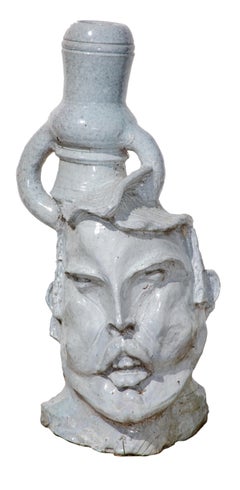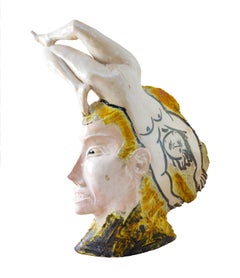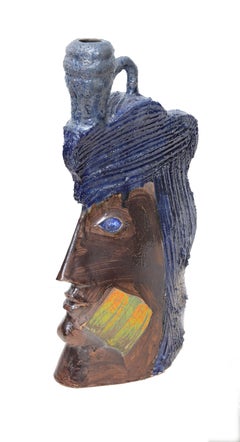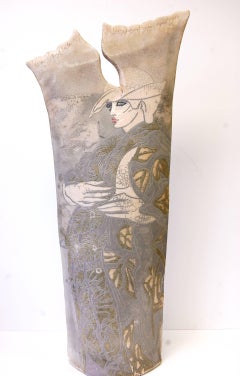Steven Kemenyffy Figurative Sculptures
to
1
2
Overall Width
to
Overall Height
to
3
2
1
3
2
1
1
1
1
1
1
1
3
3
125
100
94
88
3
Artist: Steven Kemenyffy
Rush Limbaugh (hair parted in center, mouth open)
By Steven Kemenyffy
Located in Milwaukee, WI
31" in height roughly 12-15" wide
Ceramic
Steven Kemenyffy (born 1943) is an American ceramic artist living and working in Pennsylvania. He is most recognized for his contributions to the development of the American ceramic raku tradition. He has served as a Professor of Ceramic Art at Edinboro University of Pennsylvania (formerly Edinboro State College) since 1969. He Has retired from teaching, but continues to produce artwork at his home studio in McKean, Pennsylvania. Kemenyffy is often characterized in regard to his contributions to American experimental ceramics of the late 1960s and early 1970s. More specifically, Kemenyffy’s contributions to American raku techniques are often cited. Kemenyffy has stated that his interest in raku came out of practical considerations: “We [Steven and Susan] were doing a variety of workshops in a variety of different media. Raku was always an official way of making pieces in a short period of time…In raku it seems to compress all the firings into one.” Kemenyffy, himself, describes his early work as “Biomorphic forms alluding to old ceramic traditions such as tiles, vases, and containers.” These works were often in excess of six feet tall and many times included mixed media elements. In 1974, Kemenyffy wrote about the work he was producing; “For several years now, my work has dealt with certain formal considerations. Chief among these is using clay in such a way as to crystallize the moment and permanentize the impermanent. These have been among the primary concerns of all potters since the earliest times.” Today, Kemenyffy continues his pursuit of biomorphic imagery and themes. He writes, “Personally I am most challenged by the business of transforming porous organics into porcelain.” For much of Kemenyffy’s career, he has worked in tandem with his wife, Susan Hale Kemenyffy. In 1987 Susan stated about their collaborative works: “Steven is the [sculptor], I am the drawer. These works would not exist if it weren’t for the sculpture; if it weren’t for the clay. The clay entity comes first and my drawings come second.” James Paul Thompson further clarifies this relationship (as observed in 1987): “Steven Kemenyffy uses patterns as a point of departure for his work, while Susan Kemenyffy...
Category
1990s Steven Kemenyffy Figurative Sculptures
Materials
Ceramic
'Can't Get Her Off My Mind' Ceramic Sculpture
By Steven Kemenyffy
Located in Milwaukee, WI
"Can't Get Her Off My Mind" is an original ceramic sculpture created by Steven Kemenyffy.
43"x30"x14"
Ceramic
Steven Kemenyffy (born 1943) is an American ceramic artist living and working in Pennsylvania. He is most recognized for his contributions to the development of the American ceramic raku tradition. He has served as a Professor of Ceramic Art at Edinboro University of Pennsylvania (formerly Edinboro State College) since 1969. He Has retired from teaching, but continues to produce artwork at his home studio in McKean, Pennsylvania. Kemenyffy is often characterized in regard to his contributions to American experimental ceramics of the late 1960s and early 1970s. More specifically, Kemenyffy’s contributions to American raku techniques are often cited. Kemenyffy has stated that his interest in raku came out of practical considerations: “We [Steven and Susan] were doing a variety of workshops in a variety of different media. Raku was always an official way of making pieces in a short period of time…In raku it seems to compress all the firings into one.” Kemenyffy, himself, describes his early work as “Biomorphic forms alluding to old ceramic traditions such as tiles, vases, and containers.” These works were often in excess of six feet tall and many times included mixed media elements. In 1974, Kemenyffy wrote about the work he was producing; “For several years now, my work has dealt with certain formal considerations. Chief among these is using clay in such a way as to crystallize the moment and permanentize the impermanent. These have been among the primary concerns of all potters since the earliest times.” Today, Kemenyffy continues his pursuit of biomorphic imagery and themes. He writes, “Personally I am most challenged by the business of transforming porous organics into porcelain.” For much of Kemenyffy’s career, he has worked in tandem with his wife, Susan Hale Kemenyffy. In 1987 Susan stated about their collaborative works: “Steven is the [sculptor], I am the drawer. These works would not exist if it weren’t for the sculpture; if it weren’t for the clay. The clay entity comes first and my drawings come second.” James Paul Thompson further clarifies this relationship (as observed in 1987): “Steven Kemenyffy uses patterns as a point of departure for his work, while Susan Kemenyffy...
Category
1980s Steven Kemenyffy Figurative Sculptures
Materials
Ceramic
'History of Pottery, Africa' Ceramic Sculpture
By Steven Kemenyffy
Located in Milwaukee, WI
41x25x10"
Ceramic
Steven Kemenyffy (born 1943) is an American ceramic artist living and working in Pennsylvania. He is most recognized for his contributions to the development of the American ceramic raku tradition. He has served as a Professor of Ceramic Art at Edinboro University of Pennsylvania (formerly Edinboro State College) since 1969. He Has retired from teaching, but continues to produce artwork at his home studio in McKean, Pennsylvania. Kemenyffy is often characterized in regard to his contributions to American experimental ceramics of the late 1960s and early 1970s. More specifically, Kemenyffy’s contributions to American raku techniques are often cited. Kemenyffy has stated that his interest in raku came out of practical considerations: “We [Steven and Susan] were doing a variety of workshops in a variety of different media. Raku was always an official way of making pieces in a short period of time…In raku it seems to compress all the firings into one.” Kemenyffy, himself, describes his early work as “Biomorphic forms alluding to old ceramic traditions such as tiles, vases, and containers.” These works were often in excess of six feet tall and many times included mixed media elements. In 1974, Kemenyffy wrote about the work he was producing; “For several years now, my work has dealt with certain formal considerations. Chief among these is using clay in such a way as to crystallize the moment and permanentize the impermanent. These have been among the primary concerns of all potters since the earliest times.” Today, Kemenyffy continues his pursuit of biomorphic imagery and themes. He writes, “Personally I am most challenged by the business of transforming porous organics into porcelain.” For much of Kemenyffy’s career, he has worked in tandem with his wife, Susan Hale Kemenyffy. In 1987 Susan stated about their collaborative works: “Steven is the [sculptor], I am the drawer. These works would not exist if it weren’t for the sculpture; if it weren’t for the clay. The clay entity comes first and my drawings come second.” James Paul Thompson further clarifies this relationship (as observed in 1987): “Steven Kemenyffy uses patterns as a point of departure for his work, while Susan Kemenyffy...
Category
1980s Steven Kemenyffy Figurative Sculptures
Materials
Ceramic
Related Items
Yellow Swimmer 2 Large - Handmade Modern Glazed Ceramics Sculpture, Man Portrait
By Tomasz Bielak
Located in Salzburg, AT
The sculpture is signed below, inside
Tomasz Bielak born in Lublin in 1967. He graduated of The Academy of Fine Arts, Painting and Graphics Design Department in Gdańsk, in 1994....
Category
2010s Contemporary Steven Kemenyffy Figurative Sculptures
Materials
Ceramic, Glaze
$2,015
H 9.45 in W 9.45 in D 7.49 in
Pair of Neoclassical Terracotta Bust of Emperor Caracalla and Cicero
Located in Rome, IT
Pair of 19' century Italian Marble imitation painted Terracotta .
Bust of Emperor Caracalla and Cicero .
Measurements : cm 71 H x 60
Available also a pair marble imitation colum...
Category
1870s Academic Steven Kemenyffy Figurative Sculptures
Materials
Terracotta
$14,228
H 27.96 in W 23.63 in D 13.78 in
Ancient Greek Terracotta Comic Actor Figurine
Located in Milan, IT
TERRACOTTA FIGURINE OF A COMIC ACTOR , Greece, c. 350 B.C.
Labeled to the reverse, 'LAWRENCE COLL./LOT 426. SOTHEBY./APR. 1892. P. 816.';
Terracotta
height 15.2 cm
height 6 in
Prove...
Category
15th Century and Earlier Steven Kemenyffy Figurative Sculptures
Materials
Terracotta, ABS
Women figure. I 2013, porcelain, h 17, 5 cm
By Ilona Romule
Located in Riga, LV
Women figure. I
2013, porcelain, h 17,5 cm
by Ilona Romule, leading sculptor in Latvia
''Women Figure" in porcelain is a small-scale sculpture that emb...
Category
2010s Contemporary Steven Kemenyffy Figurative Sculptures
Materials
Porcelain
$455 Sale Price
20% Off
H 6.89 in W 2.76 in D 1.97 in
Antique Italian Terracotta Figure Of The Child Hercules, Rome, 18th Century
Located in Milan, IT
After Alessandro Algardi (Bologna, 1585 - Roma,1654)
YOUNG HERCULES, Italy, 18th Century
terracotta
44 x 25 x 25 cm
17 1/4 x 9 3/4 x 9 3/4 in
This lovely sculpture represents the young Hercules, seated with his legs crossed, gently holding a bird with his right hand, raised in the air, while supporting his own weight with his left hand.
The artwork refers to the notorious Roman sculpture of the young Hercules killing the snakes sent by Hera, exhibited at the Capitoline Museums in Rome. Academics have identified the young emperor Caracalla or, more recently, Annio Vero, son of the emperor Marcus Aurelius, in the portrait of the sculpture.
During the 16th Century there has been an increasing interest of patrons towards the theme of mythology and several acclaimed Italian sculptors worked on the creation of sculptures and depictions of Roman Gods.
Among them, the distinguished baroque artist Alessandro Algardi worked on the restoration of several ancient sculptures...
Category
18th Century Steven Kemenyffy Figurative Sculptures
Materials
Terracotta
$11,855
H 17.33 in W 9.85 in D 9.85 in
Women figure on a pedestal Porcelain, silver, h 20 cm
By Ilona Romule
Located in Riga, LV
Women figure on a pedestal
Porcelain, silver, h 20 cm
by Ilona Romule, leading sculptor in Latvia
The "Women Figure on a Pedestal" is a decorative art p...
Category
2010s Contemporary Steven Kemenyffy Figurative Sculptures
Materials
Silver
$901 Sale Price
20% Off
H 7.88 in W 3.15 in D 3.15 in
Mom Rat With Babies - Unique Handmade Glazed Ceramics Sculpture, Animals
By Monika Zadurska-Bielak
Located in Salzburg, AT
The sculpture is signed below.
Monika Zadurska-Bielak, Graduated from the studio of Prof. Franciszek Duszeńko at the Faculty of Sculpture of the Acade...
Category
2010s Contemporary Steven Kemenyffy Figurative Sculptures
Materials
Ceramic
Monika Zadurska-BielakMom Rat With Babies - Unique Handmade Glazed Ceramics Sculpture, Animals, 2020
$711
H 5.91 in W 2.76 in D 3.15 in
Bust of a Lady, Madame Comtesse Du Barry, Terracotta Bust, French Antique School
Located in Greven, DE
A powerful presentation piece, this stunning bust of Jean Bécu - Comtesse du Barry is both beautiful and tragic. Executed in terracotta that has been...
Category
19th Century Rococo Steven Kemenyffy Figurative Sculptures
Materials
Terracotta
$4,267
H 22.45 in W 13.39 in
19th Century Madonna Adoring the Infant Jesus Italian School Ceramic White Blue
Located in Sanremo, IT
Cantagalli-manufactured ceramics measuring 125 x 67 cm depicting a sweet Madonna adoring the Child Jesus and the Holy Spirit.
At the beginning of the 19th century, Ulisse Cantagalli...
Category
1830s Italian School Steven Kemenyffy Figurative Sculptures
Materials
Ceramic
$17,783
H 49.22 in W 26.38 in
Bird in Flight
Located in Washington, DC
German Romanian artist, Otto Scherer, pays homage to one of the most important artists of the 20th century, Brancusi, in his ceramic "Bird in Flight".
Category
2010s Modern Steven Kemenyffy Figurative Sculptures
Materials
Platinum
Tall Metallic Palladium Abstract Expressionist Brutalist Totem Sculpture
By Judy Engel
Located in Hudson, NY
Hand built heavily glazed solid ceramic structure by NY artist Judy Engel.
Expressionist style hand built and heavily glazed in a high metallic palladium glaze. Judy's first introduction to this style was the Empire State Plaza in Albany, NY. "In the 1970s, upstate school kids...
Category
21st Century and Contemporary Abstract Expressionist Steven Kemenyffy Figurative Sculptures
Materials
Ceramic, Glaze
$3,200
H 16.5 in W 5.5 in D 5 in
Giant foot #2 - series of body parts, stoneware clay, color grey, black
By Irina Lakshin
Located in Fort Lee, NJ
Giant foot #2. This sculpture is from my series of Body parts. It is a giant foot about 17 inches (46 cm) long, made with stoneware clay and fired in electric kiln. Styles: Expressio...
Category
21st Century and Contemporary Modern Steven Kemenyffy Figurative Sculptures
Materials
Ceramic, Clay, Stoneware
$2,999
H 10 in W 7.5 in D 17 in
Previously Available Items
Large Raku Ceramic Floor Sculpture With Woman
By Steven Kemenyffy
Located in Lake Worth Beach, FL
Large Raku Glazed Ceramic Pottery Sculpture Double-Sided.
Size:49"x22"x10"
Signed and dated title.
Susan and Steven Kemenyffy Americans Susan B: 1941, Stephen B: 1943. Mr. Kemenyffy...
Category
1980s Modern Steven Kemenyffy Figurative Sculptures
Materials
Ceramic
Steven Kemenyffy figurative sculptures for sale on 1stDibs.
Find a wide variety of authentic Steven Kemenyffy figurative sculptures available for sale on 1stDibs. You can also browse by medium to find art by Steven Kemenyffy in ceramic and more. Much of the original work by this artist or collective was created during the 20th century and is mostly associated with the modern style. Not every interior allows for large Steven Kemenyffy figurative sculptures, so small editions measuring 12 inches across are available. Customers who are interested in this artist might also find the work of Seena Donneson, Walter Bastianetto, and Anthony Quinn. Steven Kemenyffy figurative sculptures prices can differ depending upon medium, time period and other attributes. On 1stDibs, the price for these items starts at $2,500 and tops out at $14,500, while the average work can sell for $8,213.
Artists Similar to Steven Kemenyffy
Bernard Rives



